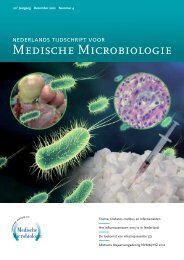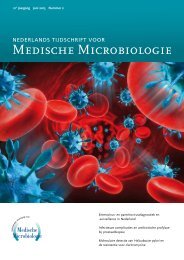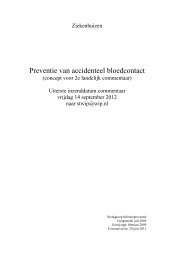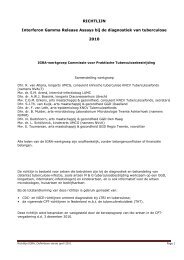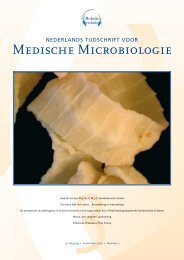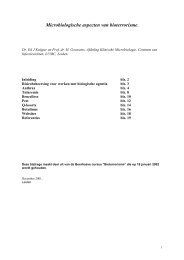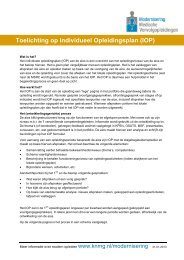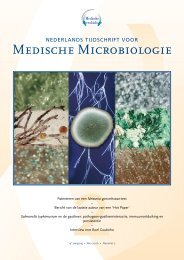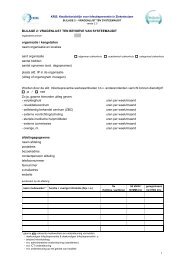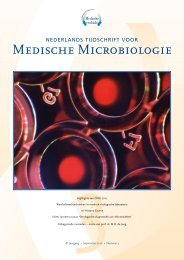S1 De voorjaarsbijeenkomst van de Nederlandse ... - NVMM
S1 De voorjaarsbijeenkomst van de Nederlandse ... - NVMM
S1 De voorjaarsbijeenkomst van de Nederlandse ... - NVMM
Create successful ePaper yourself
Turn your PDF publications into a flip-book with our unique Google optimized e-Paper software.
to modulate immune responses by suppressing IL-12<br />
production by <strong>de</strong>ndritic cells (DCs). Although this effect<br />
could clearly be ascribed to the glucan, the un<strong>de</strong>rlying<br />
mechanism remained unexplained. The goal of this project<br />
was to unravel this mechanism by i<strong>de</strong>ntifying the host<br />
alpha-glucan receptors and investigating their role in<br />
glucan-mediated immunomodulation. For this, we screened<br />
the glucan-binding capacity of various lectins using<br />
lectin-Fc constructs and found that alpha-glucan specifically<br />
interacts with the C-type lectin DC-SIGN. This lectin was<br />
previously shown to be important for the binding to and<br />
modulation of DCs by mycobacteria. To see whether alphaglucan<br />
could also bind to DC-SIGN on the cell surface, we<br />
incubated fluorescently-labelled polystyrene beads coated<br />
either with alpha-glucan or with human serum albumin<br />
as a control together with Raji cells, Raji cells expressing<br />
DC-SIGN, or DCs and analysed binding of the beads by<br />
flow cytometry. The results showed that the glucan-coated<br />
beads specifically bound to both the DCs and the Raji cells<br />
expressing DC-SIGN, but not to the Raji cells alone, and<br />
that this interaction could be abrogated by pre-incubating<br />
with mannan or with antibodies that block DC-SIGN.<br />
These results clearly <strong>de</strong>monstrate that mycobacterial alphaglucan<br />
binds to DC-SIGN and that this interaction may be<br />
important for its immunomodulatory activity.<br />
Alpha-glucan is not unique to mycobacteria and similar<br />
molecules can be found in a number of species including<br />
some fungi. Interestingly, alpha-glucan from the fungus<br />
Pseudallescheria boydii has been reported to induce the<br />
secretion of pro-inflammatory cytokines in a mechanism<br />
involving toll-like receptor 2 (TLR2). To test whether<br />
mycobacterial alpha-glucan can also activate TLR2, we<br />
incubated TLR2-transfected HEK293 cells with alphaglucan<br />
and measured the TLR2-<strong>de</strong>pen<strong>de</strong>nt production of<br />
IL-8. Interestingly, our results showed that mycobacterial<br />
alpha-glucan, like the fungal glucan, can activate TLR2.<br />
Thus, besi<strong>de</strong>s binding to DC-SIGN, alpha-glucan can also<br />
bind and activate TLR2. Exactly how this interaction occurs<br />
and what influence it has on the host immune-response is<br />
currently unknown. Our current experiments are aimed at<br />
providing insight into these important questions.<br />
O069<br />
The Mycoplasma pneumoniae MPN229 gene enco<strong>de</strong>s a<br />
protein that selectively binds single-stran<strong>de</strong>d dNA and<br />
stimulates RecA-mediated dNA strand exchange<br />
C. Vink, M. Sluijter, T. Hoogenboezem, N.G. Hartwig<br />
Laboratory of Pediatrics, <strong>De</strong>pt. of Pediatric Infectious Diseases,<br />
Erasmus University Medical Centre, Rotterdam<br />
Mycoplasma pneumoniae has previously been characterised<br />
as a micro-organism that is genetically highly<br />
stable. In spite of this genetic stability, homologous DNA<br />
Ned Tijdschr Med Microbiol 2008;16:Supplement<br />
S30<br />
recombination has been hypothesised to lie at the basis<br />
of antigenic variation of the major surface protein, P1, of<br />
M. pneumoniae. In or<strong>de</strong>r to i<strong>de</strong>ntify the proteins that may<br />
be involved in homologous DNA recombination in M.<br />
pneumoniae, we set out to characterise the MPN229 open<br />
reading frame (ORF), which bears sequence similarity<br />
to the gene encoding the single-stran<strong>de</strong>d DNA-binding<br />
(SSB) protein of Escherichia coli. The MPN229 ORF has<br />
the capacity to enco<strong>de</strong> a 166-amino acid protein with a<br />
calculated molecular mass of 18.4 kDa. The amino acid<br />
sequence of this protein (Mpn SSB) is most closely related<br />
to that of the protein predicted to be enco<strong>de</strong>d by the MG091<br />
gene from Mycoplasma genitalium (61% i<strong>de</strong>ntity). The<br />
MPN229 ORF was cloned, and Mpn SSB was expressed<br />
in E. coli and purified. The Mpn SSB protein was found<br />
to: i) exist primarily as dimer in solution, ii) selectively<br />
bind single-stran<strong>de</strong>d DNA in a divalent cation- and DNA<br />
substrate sequence-in<strong>de</strong>pen<strong>de</strong>nt manner, and iii) stimulate<br />
E. coli RecA-promoted DNA strand exchange.<br />
We conclu<strong>de</strong> that Mpn SSB represents the M. pneumoniae<br />
counterpart of the E. coli SSB protein. The results from this<br />
study will pave the way for unraveling the DNA recombinatorial<br />
pathways in M. pneumoniae.<br />
O070<br />
Comparative genomic profiling of dutch clinical Bor<strong>de</strong>tella<br />
pertussis isolates using dNA microarrays: i<strong>de</strong>ntification of<br />
genes absent from epi<strong>de</strong>mic strains<br />
A.J. King1 , T. <strong>van</strong> Gorkom1 , H. G. J. <strong>van</strong> <strong>de</strong>r Hei<strong>de</strong>1 , Q. He2 ,<br />
J. Pennings1 , F.R. Mooi1 1Cib-Laboratory for Infectious Diseases, National Institute<br />
for Public Health and the Environment (RIVM), Bilthoven,<br />
2<br />
KTL, Turku, Finland<br />
Introduction: Bor<strong>de</strong>tella pertussis causes whooping cough or<br />
pertussis in humans and is particularly severe in infants.<br />
<strong>De</strong>spite vaccination, whooping cough remains a public<br />
health problem. Since the 1990s, a significant increase in<br />
the B. pertussis inci<strong>de</strong>nce was observed in many countries.<br />
Also in the Netherlands, an increase in B. pertussis has been<br />
observed since 1996. Several causes for the re-emergence<br />
have been suggested, there is evi<strong>de</strong>nce that pathogen<br />
adaptation also plays a role. Numerous studies have <strong>de</strong>monstrated<br />
that the B. pertussis population has changed since<br />
the start of vaccination. In several countries, the B. pertussis<br />
population was found to be variable since polymorphisms<br />
in surface proteins were found. In the Netherlands, we<br />
observed that strains with a particular allele of the ptx<br />
promoter (ptxP) i.e. ptxP3 have expan<strong>de</strong>d in the Dutch B.<br />
pertussis population. The increase in frequency coinci<strong>de</strong>d<br />
the increase in B. pertussis notifications in the Netherlands.<br />
We aimed to use microarrays to i<strong>de</strong>ntify additional changes<br />
in strains associated with the Dutch epi<strong>de</strong>mic.




